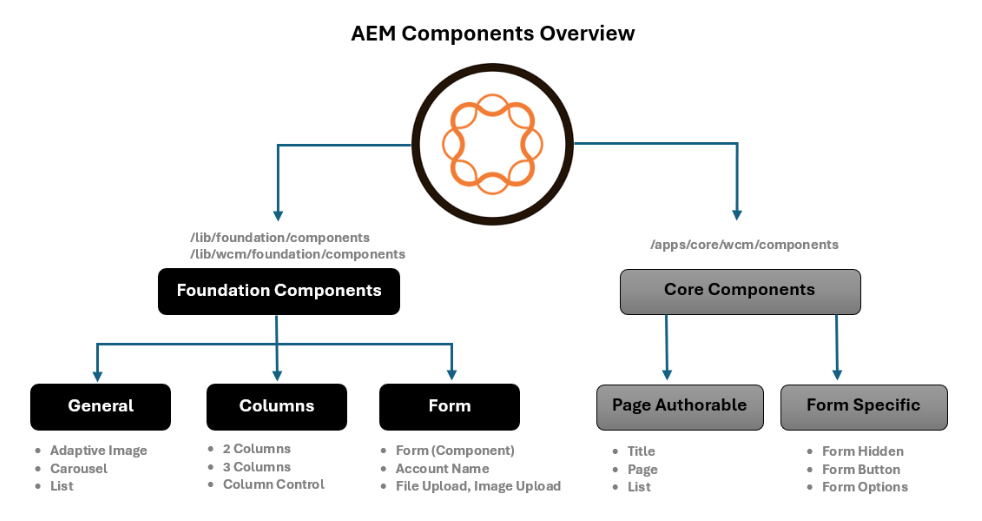Adobe Experience Manager (AEM) is a sophisticated and versatile content management tool. Components are the elements that help structure the page, for example, the header, body, and footer, through authoring. AEM’s core components, have always allowed authors to create pages that are both efficient and simple to use, whereas developers can create components that are customizable and expandable. In this blog, we will look at the mysterious world of AEM components and how they impact the platform’s overall functionality and user experience.
Classification of AEM Components:
Definition and Types: AEM components are customizable elements that offer unique features or content. Components are classified into two categories:
- Core components accessible through AEM out of the box, and custom components designed to fit specific business needs.
- Foundational components comprise text, pictures, and navigation components.

Fig. Types of Components
However, users may create, manage, and publish digital content with Adobe Experience Manager (AEM), a potent web content management system. AEM components are crucial to the process of creating webpages. They have a variety of functions and can be tailored to meet certain requirements. Developing effective and efficient websites requires a thorough understanding of the various AEM component types and their applications.
Applications of the AEM components:
- Content Authoring: Components offer efficient content creation and management. Authors can leverage the user-friendly AEM interface to drag and drop components in pages, resulting in dynamic and visually appealing layouts. This visual creation method minimizes the need for developers to do routine content changes.

Fig. Author and Publisher
- Responsive Design: AEM components are especially important for responsive design. Furthermore, mobile devices are becoming more common, components are designed to work easily across a wide range of platforms, ensuring a positive user experience. This flexible design feature is critical to reaching a wider demographic.

Fig. Responsive Viewer
- Customization and Extensibility: AEM’s custom components enable business entities to build digital experiences to meet specific business demands. Developers can develop customized components that interact with other applications, furnish specialized functionality, or comply with certain design specifications, giving them outstanding flexibility.
Merits of AEM Components:
- AEM Core Components offer uniformity, which shortens development processes and saves time.
- Core Components are intended to be robust and adaptable. They provide a stable basis for website development, helping you to easily add unique AEM functionality, connect external apps, and adapt to shifting business requirements.
- Adaptability ensures that websites designed with Core Components tend to evolve and develop alongside the business you represent.
- AEM Core Components adhere to best practices for effective rendering, caching, and structured data since they are performance and SEO (Search Engine Optimization) emphasized.
Behind the Scenes: A Glimpse into Component Development
- Component Structure: Components in AEM are developed following a structured approach. This includes creating the component’s Java logic, defining its dialog for content authoring, and designing the component’s frontend using HTML (HTML Template Language) or JSP (Java Server Pages). This separation of concerns ensures maintainability and ease of development.
- Component Lifecycle: Understanding the lifecycle of an AEM component is crucial for developers. Components go through initialization, rendering, and destruction phases. Developers need to be mindful of these stages to specifically optimize component behavior and performance.
Conclusion:
The components of Adobe Experience Manager are integral in creating customized and engaging digital experiences, as they join together to form a smooth and fascinating user experience. Their importance cannot be overstated in content writing, responsive design, and extensibility, as they enable businesses to create customized and engaging digital experiences. The importance of AEM components in forming the online world is constant, even as we negotiate the ever-changing terrain of digital encounters.



Thanks for sharing knowledge, content is very good and helpful.